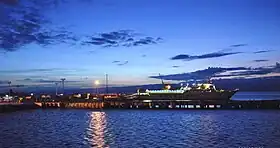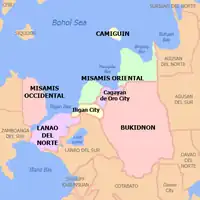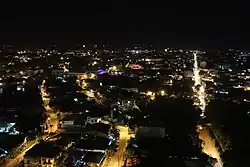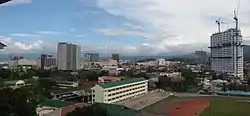Ozamiz
Ozamiz, officially the City of Ozamiz (Cebuano: Dakbayan sa Ozamiz; Filipino: Lungsod ng Ozamiz), is a 3rd class component city in the province of Misamis Occidental, Philippines. According to the 2020 census, it has a population of 140,334 people.[4]
Ozamiz | |
|---|---|
| City of Ozamiz | |
 Downtown Ozamiz | |
 Flag  Seal | |
Nicknames:
| |
| Motto(s): Fortis in Fide (Strength in Faith) | |
 Map of Misamis Occidental with Ozamiz highlighted | |
OpenStreetMap | |
.svg.png.webp) Ozamiz Location within the Philippines | |
| Coordinates: 8°09′N 123°51′E | |
| Country | Philippines |
| Region | Northern Mindanao |
| Province | Misamis Occidental |
| District | 2nd district |
| Founded | 1757 |
| Cityhood | July 16, 1948[1] |
| Named for | José Ozámiz |
| Barangays | 51 (see Barangays) |
| Government | |
| • Type | Sangguniang Panlungsod |
| • Mayor | Atty. Henry “Indy” F. Oaminal Jr. (PDPLBN) |
| • Vice Mayor | Simplicia “Bebie” O. Neri (PDPLBN) |
| • Representative | Sancho Fernando “Ando” F. Oaminal (NP) |
| • City Council | Members |
| • Electorate | 98,929 voters (2022) |
| Area | |
| • Total | 169.95 km2 (65.62 sq mi) |
| Elevation | 216 m (709 ft) |
| Highest elevation | 1,923 m (6,309 ft) |
| Lowest elevation | 0 m (0 ft) |
| Population (2020 census)[4] | |
| • Total | 140,334 |
| • Density | 830/km2 (2,100/sq mi) |
| • Households | 32,933 |
| Economy | |
| • Income class | 3rd city income class |
| • Poverty incidence | 21.12 |
| • Revenue | ₱ 1,058 million (2020) |
| • Assets | ₱ 1,763 million (2020) |
| • Expenditure | ₱ 749.6 million (2020) |
| • Liabilities | ₱ 333.6 million (2020) |
| Service provider | |
| • Electricity | Misamis Occidental 2 Electric Cooperative (MOELCI 2) |
| Time zone | UTC+8 (PST) |
| ZIP code | 7200 |
| PSGC | |
| IDD : area code | +63 (0)88 |
| Native languages | Subanon Cebuano Tagalog |
| Feast date | July 16 ; December 8 |
| Catholic diocese | Archdiocese of Ozamis |
| Patron saint | Blessed Virgin of Cotta |
| Website | ozamizcity |
Although occasionally spelled as Ozamis in official sources like COMELEC,[6] it is spelled as Ozamiz[7] in Republic Act No. 321, the Ozamiz City Charter Act. In 2005, City Resolution 251-05 was passed to reiterate that it is officially spelled Ozamiz, not Ozamis.
History

The city of Ozamiz grew out of an old Spanish town called Misamis—a name believed to have been derived from the Subanen word kuyamis, a variety of coconut. Other unverified historical sources, however, suggest that the name Misamis came from the Spanish word Misa (Catholic Mass). The old Spanish town grew in size due to the nearby Spanish garrison stationed at the stone fort named Fuerte de la Concepcion del Triunfo. The fort was constructed some time in 1756 in order to attempt to combat the pirate activities originating in the nearby Lanao area. In 1850, the town of Misamis became the capital of the District of Misamis.
In October 1942, Wendell Fertig established the command headquarters of the growing guerrilla resistance to the Japanese occupation of Mindanao in the Spanish fort in the city. His headquarters was abandoned June 26, 1943, due to a large Japanese attack.[8] Until the end of the war, the Japanese occupied this fort. During the Japanese occupation of Misamis in World War II, the "Cotta" was garrisoned by a contingent of Japanese who dug foxholes near or under the walls. This undermining of walls later led to the destruction of the southwest bastion in the earthquake of 1955.[1]
After the war, Misamis became a chartered city by virtue of Republic Act 321 on July 16, 1948. This also renamed Misamis to Ozamiz after a hero José Ozámiz who hailed from the province of Misamis Occidental and who at one time also served as its governor and congressional representative of the Lone District of Misamis Occidental, a delegate to the 1935 Constitutional Convention that resulted in the creation of the 1935 Constitution for the Philippine Commonwealth Government. In 1941, José Ozámiz was elected to the Philippine Senate.
Geography
Ozamiz is nearby the Zamboanga del Sur and Zamboanga del Norte provinces, while Lanao del Norte is across the bay. Ozamiz is 52 kilometers (32 mi) from Maria Cristina Falls, the main source of hydroelectric power in Mindanao.
Climate
| Climate data for Ozamiz City, Misamis Occidental | |||||||||||||
|---|---|---|---|---|---|---|---|---|---|---|---|---|---|
| Month | Jan | Feb | Mar | Apr | May | Jun | Jul | Aug | Sep | Oct | Nov | Dec | Year |
| Average high °C (°F) | 29 (84) |
30 (86) |
31 (88) |
31 (88) |
30 (86) |
30 (86) |
29 (84) |
30 (86) |
30 (86) |
30 (86) |
30 (86) |
30 (86) |
30 (86) |
| Average low °C (°F) | 22 (72) |
22 (72) |
22 (72) |
23 (73) |
24 (75) |
24 (75) |
24 (75) |
24 (75) |
24 (75) |
24 (75) |
23 (73) |
23 (73) |
23 (74) |
| Average precipitation mm (inches) | 69 (2.7) |
58 (2.3) |
67 (2.6) |
60 (2.4) |
109 (4.3) |
114 (4.5) |
83 (3.3) |
78 (3.1) |
76 (3.0) |
92 (3.6) |
86 (3.4) |
63 (2.5) |
955 (37.7) |
| Average rainy days | 12.8 | 11.6 | 14.8 | 17.4 | 24.8 | 23.5 | 20.7 | 18.5 | 17.4 | 22.5 | 21.6 | 15.6 | 221.2 |
| Source: Meteoblue (modeled/calculated data, not measured locally)[9] | |||||||||||||
Barangays
Ozamiz is politically subdivided into 51 barangays. [10] Each barangay consists of puroks while some have sitios.
| Name | Population (2015)[11] | PSGC |
|---|---|---|
| 50th District (Poblacion) | 1,138 | 104210051 |
| Aguada (Poblacion) | 7,543 | 104210001 |
| Bacolod | 2,226 | 104210003 |
| Bagakay | 3,955 | 104210004 |
| Balintawak | 660 | 104210005 |
| Bañadero (Poblacion) | 8,000 | 104210002 |
| Baybay San Roque | 3,527 | 104210043 |
| Baybay Santa Cruz | 1,852 | 104210006 |
| Baybay Triunfo | 2,817 | 104210007 |
| Bongbong | 2,742 | 104210008 |
| Calabayan | 3,353 | 104210009 |
| Capucao C. | 652 | 104210010 |
| Capucao P. | 1,419 | 104210011 |
| Carangan | 5,223 | 104210012 |
| Carmen (Misamis Annex) | 6,135 | 104210037 |
| Catadman-Manabay | 7,422 | 104210013 |
| Cavinte | 620 | 104210014 |
| Cogon | 1,417 | 104210015 |
| Dalapang | 636 | 104210016 |
| Diguan | 1,503 | 104210017 |
| Dimaluna | 3,020 | 104210018 |
| Doña Consuelo | 4,178 | 104210052 |
| Embargo | 863 | 104210019 |
| Gala | 935 | 104210020 |
| Gango | 5,686 | 104210021 |
| Gotokan Daku | 531 | 104210022 |
| Gotokan Diot | 413 | 104210023 |
| Guimad | 750 | 104210024 |
| Guingona | 596 | 104210025 |
| Kinuman Norte | 1,484 | 104210026 |
| Kinuman Sur | 1,172 | 104210027 |
| Labinay | 1,600 | 104210028 |
| Labo | 3,065 | 104210029 |
| Lam-an | 2,961 | 104210030 |
| Liposong | 823 | 104210031 |
| Litapan | 898 | 104210032 |
| Malaubang | 7,867 | 104210033 |
| Manaka | 898 | 104210034 |
| Maningcol | 6,951 | 104210035 |
| Mentering | 439 | 104210036 |
| Molicay | 3,581 | 104210038 |
| Pantaon | 1,083 | 104210040 |
| Pulot | 4,328 | 104210041 |
| San Antonio | 4,353 | 104210042 |
| Sangay Daku | 777 | 104210044 |
| Sangay Diot | 445 | 104210045 |
| Sinusa | 1,724 | 104210046 |
| Stimson Abordo (Montol) | 2,246 | 104210039 |
| Tabid | 3,958 | 104210047 |
| Tinago | 10,596 | 104210048 |
| Trigos | 776 | 104210049 |
Demographics
|
|
| ||||||||||||||||||||||||||||||||||||||||||||||||||||||
| Source: Philippine Statistics Authority[11][12][13][14] | ||||||||||||||||||||||||||||||||||||||||||||||||||||||||
In the 2020 census, Ozamiz had a population of 140,334 people,[4] with a density of 830 inhabitants per square kilometer or 2,100 inhabitants per square mile.
Economy
Ozamiz is agricultural in terms of natural resources, but the city has become the center for commerce, health, transportation, and education, considering its strategic location. Its location makes for a good harbor, as its local port is the principal outlet of mineral deposits and agricultural and forest products of the provinces of Misamis Occidental, Zamboanga del Norte, Zamboanga del Sur, Maguindanao, parts of Lanao del Norte, and Lanao del Sur.
Retail
Ozamiz has several notable shopping centers within its city center.
- Gaisano Capital Mall is the largest mall in the city with the expansion of a new South Wing Mall in 2011.
- Novo also expanded and constructed a larger structure with a hotel named Asia Novotel in 2010.
- Unitop Ozamiz also expanded their building in front of the City Public Mall in 2012.
- City Public Mall, formerly known as City Public Market, is the biggest public establishment in Northwestern Mindanao. It is owned and managed by the Ozamiz government and was opened on May 28, 2009.
- Robinsons Supermarket opened to the public on November 30, 2012.
- Puregold Ozamiz opened in the year 2019 with the first-ever 7-Eleven serving the developing city.
Government
Local officials are elected every 3 years. The city local government is composed of the mayor, vice mayor, ten councilors, one Sangguniang Kabataan (SK) representative, one indigenous people (IPMR) representative, and an Association of Barangay Captains (ABC) representative.
Elected officials
| Congressman | |||
|---|---|---|---|
| Sancho Fernando "Ando" F. Oaminal (NP) | |||
| Mayor | Vice Mayor | ||
| Atty. Henry “Indy” F. Oaminal Jr. (PDPLBN) | Simplicia "Bebie" O. Neri (PDPLBN) | ||
| Councilors | |||
| Marcelo Archie S. Romero II (Asenso Pinoy) | Juanito "Junjun" B. Saquin Jr. (Asenso Pinoy) | Cecille Y. Co (Asenso Pinoy) | Roland "Dinky" B. Suizo Jr. (NP) |
| Anita "Nene" M. Linsag (PDPLBN) | Atty. Daniel C. Lao (NP) | Atty. Marcelian "Mars" C. Tapayan (PDPLBN) | Lorlie Fuentes-Cipres (NP) |
| Saulo E. Salvador (PDPLBN) | Katherine "Kat-Kat" C. Lim (Asenso Pinoy) | John P. Docdor (ABC) | Erwin B. Ochavillo (SK) |
| Relinda A. Bation (IPMR) | |||
Culture
Notable events and festivals
Ozamiz's Charter Day anniversary, the feast of Our Lady of Triumph of the Cross at Cotta Shrine, and the Subayan Keg Subanon festival are celebrated on July 16. During both holidays, firework displays are held near the Cotta Shrine. Every December 8, the Feast of Our Lady of Immaculate Conception is celebrated. The Sr. Santo Nino Fluvial Parade, held at Panguil Bay is celebrated every 4th Sunday of January.
Tourism

Fuerte de la Concepcion y del Triunfo, also known as Cotta Shrine, is a fort built in 1756 by Father José Ducos to serve as a Spanish outpost in the area. A special chapel was built inside the walls of the fort and an image of the Virgin of the Immaculate Conception was enshrined in the chapel. An image of the Virgin Mary (Nuestra Señora de la Immaculada Concepción y del Triunfo de la Cruz de Migpangi) was carved on the outside wall of the fort, facing the sea. The image is believed to be miraculously growing and has been a pilgrimage destination. In 2022, the fort was renovated and restored to its original design. As of now, Cotta is undergoing a development consisting of the construction of a boulevard with a Spanish galleon replica, a park, a mini commercial complex for food stalls, ticketing offices, restos, cafes, and souvenir shops.
Bukagan Hill has a view of the city, Panguil Bay, and the provinces of Lanao del Norte and Zamboanga del Sur. There are four great bells at the top of Bukagan Hill, named "St. Peter", "St. Marien", "St. Joseph", and "St. Michael". They were originally purchased by Bishop Patrick Cronin, D.D., for the Metropolitan Cathedral of the Immaculate Conception. However, the bells weigh 7 tons and were found to be too heavy and too large for the cathedral's belfry. Given the recent costs of installing an organ at the cathedral, it was commonly thought that the installation of the bells would prove too expensive but, through the efforts of then City Mayor Fernando T. Bernad and Jesus Y. Varela, the bells were finally given a place at Bukagan Hill, and were officially inaugurated on July 16, 1948.[22]
Naomi's Botanical Garden and Tourist's Inn sits on a 12-hectare property. The garden features a variety local and imported tropical flowers, plants, and fruit trees. The hotel has fully air-conditioned private rooms, and is home to a variety of amenities, including function halls, a tennis court, a golf range, a ceramics factory, and a bakery.
Mt. Malindang Golf and Country Club is a pre-war army facility converted into a golf course located in Bagakay, at the foot of Mount Malindang.
The Immaculate Conception Pipe Organ, found in the choir loft of the Metropolitan Cathedral of the Immaculate Conception, is the only existing pipe organ in Mindanao, and one of only a few anywhere in the Philippines. It was Father Sean Lavery, an Irish-Columbian priest in charge of music at the cathedral, who first thought of the idea of an organ at Immaculate Conception. Funds were raised through donations and a musical extravaganza, organized by the parish, to buy the pipe organ. Father Lavery requested the aid of a German priest, Father Herman Schablitzki S.V.D., in designing the organ. Father Schatblitzki visited Ozamiz to take measurements to give to the organ builders back in Germany. Father Schablitzki himself, assisted by one carpenter and one electrician, assembled the organ in six weeks, and it was completed on May 31, 1967. It was inaugurated on July 16, 1967, the feast day of Our Lady of Mount Carmel.[23]
The Metropolitan Cathedral of the Immaculate Conception was built from the ruins of a church destroyed in an earthquake in 1955. It was one of the earliest designs of nationalist art for architecture Leandro Locsin. His simple style of squares, circles, and half circles are evident throughout the external and internal designs of the church. Alterations to the façade of the cathedral were performed later.
Transportation
Air

Ozamiz Airport, also known as Labo Airport, was reopened July 5, 2007, 9 years after Philippine Airlines (PAL) stopped their original Fokker 50 and Sunriser plane operation at the airport. The inability of the airport to accommodate jet planes due to its short runway led to its closure. Air Philippines (a subsidiary airline of PAL) was the first airline that used Ninoy Aquino International Airport in Manila, using a B737-200, the first jet plane to land at the airport. PAL Express, another PAL subsidiary, then made direct flights to Mactan–Cebu International Airport again using their Bombardier Q400.
PAL's competitor, Cebu Pacific Air, later started serving Ozamiz with their first flight to Cebu on November 10, 2008, using their brand-new ATR72-500. Due to high passenger and cargo demand, Cebu Pacific launched its Manila route with their Airbus 319, while PAL took over Air Philippine's service to Manila using their Airbus 319s on June 16, 2009.
When Air Philippines rebranded as Airphil Express (now PAL Express), it relaunched its Ozamiz to Manila service on August 18, 2011, using their Airbus A320. It then forced Cebu Pacific to change its aircraft that had previously served Ozamiz Airport, replacing all of their ATR72-500s with Airbus A319s and Airbus A320s. Despite fierce competition between PAL and Cebu Pacific, PAL ended their operations in Ozamiz on March 25, 2012, leaving their affiliate PAL Express to compete with Cebu Pacific. Since then, the competition between PAL Express and Cebu Pacific became a duopoly serving the airport.
Ozamiz Airport will undergo a P300 million expansion and development project. The project will consist of the installation of runway lights, the extension of runway from its current of length 1.9 km to 2.1 km, and the construction of a new passenger terminal building.[24][25]
Sea

There are several major shipping lines serving Cebu, Manila, and Iligan routes, including:
- 2GO Travel (formerly SuperFerry, Negros Navigation and Cebu Ferries)
- Trans-Asia Shipping Lines
- Cokaliong Shipping Lines
- Carlos A. Gothong Lines
- Philippine Span Asia Carrier Corp (PSACC, formerly Sulpicio Lines)
Cokaliong Shipping Lines increased their Cebu service from thrice to five times weekly. Local shipping lines like Daima have trips from Ozamiz to Mukas, Kolambugan, Lanao del Norte routes through roll-on/roll-off (RORO) ferries that transport passengers, cars/trucks, and goods across Panguil Bay.
Land
Most transportation within the city is done by trisikad/pedicab and motorized tricycle. For interprovincial transportation, Rural Transit, Super Five, UV Express, and public utility jeepneys like Lotradisco are predominantly used.
Healthcare
Ozamiz City currently has seven hospitals and healthcare facilities:
- Mayor Hilarion A. Ramiro Sr. Medical Center (MHARS MC): a 500-bed capacity tertiary hospital owned by the Department of Health
- Misamis University Medical center (MUMC): a tertiary hospital located at Barangay Bagakay
- Medina General Hospital: a 200-bed capacity tertiary hospital located at Barangay Carmen Annex
- Faith Hospital
- S.M. Lao Memorial Hospital
- St. Joseph General Hospital, formerly St. Mary General Hospital
- St. Padre Pio Medical Clinic: located at JEM bldg., Medina Avenue, Barangay Carmen Annex
Education
There are two universities in Ozamiz: La Salle University (formerly known as Immaculate Conception College (ICC)) and Misamis University. Most students coming from Lanao del Norte, Zamboanga del Sur, Zamboanga del Norte, and Misamis Occidental come to Ozamiz to pursue their college education. Additional schools and institutions include:
- Computer Technology College
- Immaculate Conception School of Technology (ICST)
- La Salle University
- Lighthouse Christian Academy
- Medina College-Ozamiz
- Misamis Institute of Technology
- Misamis University
- Northwestern Mindanao Institute of Technology (NMIT)
- Northwestern Mindanao School of Technology (NMST)
- Our Lady of Triumph Institute of Technology (OLTIT)
- Ozamiz City Technology and Vocational School
- St. Constance School (SCS)
- Vocational Institute of the Philippines and Maritime Training Center
Secondary schools
The secondary schools of Ozamiz are:[26]
- FMC MA School and Tutorial Services, Inc.
- Labinay National High School
- Labo National High School
- Misamis Union High School
- Ozamiz City National High School
- Ozamiz City School of Arts and Trades (OCSAT)
- Pulot National High School
- San Antonio National High School
- Stimpson Abordo National High School
Sister cities
Domestic
International
References
- "City of Ozamis (Ozamiz)". Ozamizcity.com. Retrieved July 31, 2017.
- City of Ozamiz | (DILG)
- "2015 Census of Population, Report No. 3 – Population, Land Area, and Population Density" (PDF). Philippine Statistics Authority. Quezon City, Philippines. August 2016. ISSN 0117-1453. Archived (PDF) from the original on May 25, 2021. Retrieved July 16, 2021.
- Census of Population (2020). "Region X (Northern Mindanao)". Total Population by Province, City, Municipality and Barangay. Philippine Statistics Authority. Retrieved July 8, 2021.
- "PSA Releases the 2018 Municipal and City Level Poverty Estimates". Philippine Statistics Authority. December 15, 2021. Retrieved January 22, 2022.
- "COMELEC Region X Field Offices". Commission on Elections, Republic of the Philippines. June 17, 2020. Retrieved October 18, 2021.
- "REPUBLIC ACT NO. 321 : PHILIPPINE LAWS, STATUTES AND CODES - CHAN ROBLES VIRTUAL LAWLIBRARY". www.chanrobles.com. Retrieved October 18, 2021.
- Kent Holmes, Wendell Fertig and His Guerrilla Forces in the Philippines: Fighting the Japanese Occupation, 1942-1945 (Jefferson, N.C.: McFarland & Co., 2015), p. 43.
- "Ozamiz: Average Temperatures and Rainfall". Meteoblue. Retrieved April 29, 2020.
- "Province: Misamis Occidental". PSGC Interactive. Quezon City, Philippines: Philippine Statistics Authority. Retrieved November 12, 2016.
- Census of Population (2015). "Region X (Northern Mindanao)". Total Population by Province, City, Municipality and Barangay. Philippine Statistics Authority. Retrieved June 20, 2016.
- Census of Population and Housing (2010). "Region X (Northern Mindanao)" (PDF). Total Population by Province, City, Municipality and Barangay. National Statistics Office. Retrieved June 29, 2016.
- Censuses of Population (1903–2007). "Region X (Northern Mindanao)". Table 1. Population Enumerated in Various Censuses by Province/Highly Urbanized City: 1903 to 2007. National Statistics Office.
- "Province of Misamis Occidental". Municipality Population Data. Local Water Utilities Administration Research Division. Retrieved December 17, 2016.
- "Poverty incidence (PI):". Philippine Statistics Authority. Retrieved December 28, 2020.
- "Estimation of Local Poverty in the Philippines" (PDF). Philippine Statistics Authority. November 29, 2005.
- "2003 City and Municipal Level Poverty Estimates" (PDF). Philippine Statistics Authority. March 23, 2009.
- "City and Municipal Level Poverty Estimates; 2006 and 2009" (PDF). Philippine Statistics Authority. August 3, 2012.
- "2012 Municipal and City Level Poverty Estimates" (PDF). Philippine Statistics Authority. May 31, 2016.
- "Municipal and City Level Small Area Poverty Estimates; 2009, 2012 and 2015". Philippine Statistics Authority. July 10, 2019.
- "PSA Releases the 2018 Municipal and City Level Poverty Estimates". Philippine Statistics Authority. December 15, 2021. Retrieved January 22, 2022.
- "The February Revolution and Other Reflections", by Miguel Bernad, S.J, 1986.
- "How An Entire City Built An Organ", by Bernad, Miguel S.J., Manila: Solidaridad Publishing House, 1968
- Camus, Miguel R. "7 airports up for rehab, expansion". Philippine Daily Inquirer. Retrieved July 31, 2017.
- "TIEZA sets Ozamiz park project". BusinessWorld. Retrieved July 31, 2017.
- "City of Ozamis (Ozamiz) : Schools". Archived from the original on April 4, 2005. Retrieved July 2, 2014.
- "Sister City Agreements - Jersey City Open Data". Jersey City Open Data. Retrieved September 17, 2020.
- "Sister City (Destination Jersey City)". Destination Jersey City. Archived from the original on December 21, 2010. Retrieved August 30, 2015.



